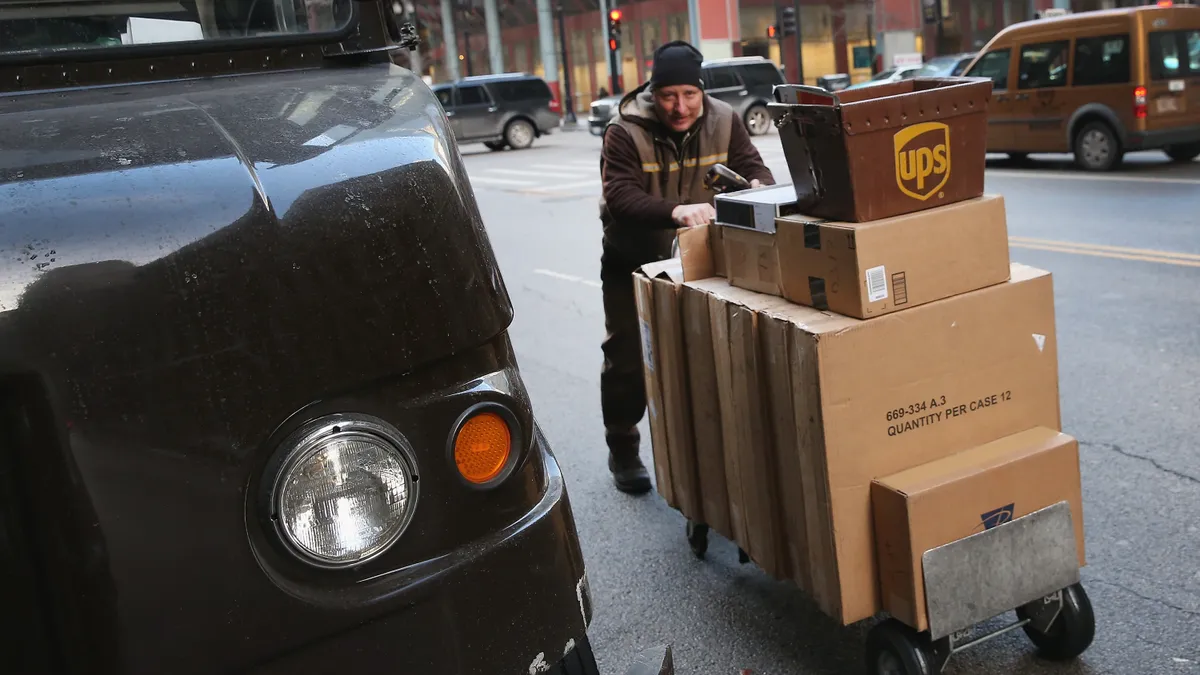Peak season surcharges are returning for the 2023 holidays, but not all carriers will partake in the annual tradition this year.
While UPS, FedEx and OnTrac are rolling out higher surcharges this peak season compared to last year, some carriers like the U.S. Postal Service are passing on the opportunity to add seasonal fees.
Although the Postal Service may be leaving money on the table, shippers "appreciate the expense relief this peak season," LPF Spend Management founder Nate Skiver, who has been tracking carriers' holiday surcharges, said in a LinkedIn post.
Here's a roundup of delivery providers that plan to levy peak season surcharges, along with those that aren't implementing added fees for their shippers.
UPS
UPS will increase the price of its demand surcharge for high-volume shippers during the peak season. The fee will range from $1.35 to $7.50 per package between Oct. 29 and Jan. 13, 2024, depending on how much volume increases for each customer it applies to.
UPS is also upping its fees on large, oversized and hard-to-handle packages from Oct. 1 to Jan. 13, 2024.
FedEx
FedEx will apply a fee to large customers that encounter volume spikes during the peak season, effective from Oct. 30 to Jan. 14, 2024. The price per package ranges from $1.35 to $6.35 for Ground shipments and $2.40 to $7.40 for Express shipments. It's also levying a surcharge for its Ground Economy services during the same time period.
Additionally, FedEx will implement surcharges on packages that are large, oversized or hard-to-handle from Oct. 2 to Jan. 14, 2024. The per-package prices of these surcharges are similar to what UPS will levy.
OnTrac
OnTrac will implement a demand surcharge for residential packages shipped from Oct. 28 through Jan. 12, 2024. The surcharge ranges from $1.35 to $6.40 per package, depending on the shipper's baseline volume.
OnTrac, which serves 31 states and Washington, D.C. through its delivery network, generally defines baseline volume as the shipper's weekly average minimum package volume from June 3 to June 30. A different time period applies to newer customers or those with much lower volume levels in September compared to June.
GLS
GLS will levy a flat $1.50 peak season surcharge on residential deliveries from Oct. 30 through Jan. 7, 2024.
"This surcharge is necessary to provide you with the high-quality service you expect during peak season," the Western U.S.-focused parcel carrier said in a message to customers.
Lone Star Overnight
Lone Star Overnight, or LSO, will apply a holiday surcharge that mirrors LSO's added fee. The Texas-based carrier with delivery coverage in the Southwest and Central U.S. is levying a flat $1.50 peak season surcharge on residential deliveries from Oct. 30 to Jan. 7, 2024.
Delivery providers with no peak surcharges
The U.S. Postal Service announced in September it would have no peak season surcharges due to continued network investments and a reduced need for seasonal hires. Companies that partner with the U.S. Postal Service for parcel delivery are also opting out of peak fees.
DHL eCommerce, which had holiday fees last year, will not apply any surcharges for the 2023 peak season, spokesperson Andrea Scarpulla said in an email.
OSM Worldwide won't levy holiday surcharges as well.
"We are proud that we can avoid additional charges on their shipments so they have a more profitable quarter,” said Gaston Curk, CEO of OSM Worldwide, in a statement.
Delivery providers Veho, AxleHire and Hailify — part of an emerging wave of FedEx and UPS alternatives — confirmed to Supply Chain Dive that they are also not going to implement any peak season surcharges.
Editor's note: This story was first published in our Logistics Weekly newsletter. Sign up here.














